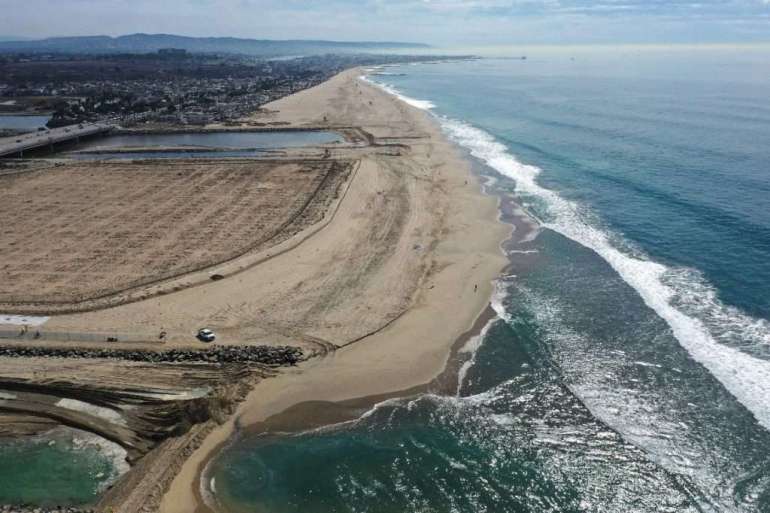Seas could rise up to a foot by 2050, posing ‘a clear and present risk’ to U.S.

“This is a global wake-up call and gives Americans the information needed to act now to best position ourselves for the future,” NOAA Administrator Rick Spinrad said in a statement.
The findings showed that failing to slash emissions will have exponentially greater consequences for people and infrastructure compared with past climatic periods, drawing from recent observational data and updated research, such as the United Nations Intergovernmental Panel on Climate Change’s latest assessment published last year, to extrapolate its results.
The federal government report said high tides and storm surge heights will increase, propelling damaging waters further inland, increasing flooding rates and turning once-dry places soggy.
“Sea level rise driven by global climate change is a clear and present risk to the United States, now and for the foreseeable future,” the report said.
Restraining global average temperature rise to 2 degrees Celsius above pre-industrial levels — a goal set by the Paris climate agreement — would yield a 50 percent likelihood that U.S. sea levels would rise more than 2 feet by 2100, the report said. But a rise of of 3 to 5 degrees Celsius would entail “much larger” sea level rise as hotter temperatures destabilize ice sheets.
One sobering fact: The world already has warmed about 1.1 degrees Celsius since the dawn of the industrial age, is not on track to meet the 2-degree goal and is even further from meeting the more ambitious goal of 1.5 degrees Celsius. Blowing past that 1.5 degrees C mark could render entire regions of the world uninhabitable.
Most nations do not have policies in place to honor commitments they made at last year’s U.N. climate talks to drastically reduce greenhouse gases during this decade. That includes President Joe Biden’s vow to slash U.S. emissions 50 to 52 percent below 2005 levels by 2030. Policies to fulfill national promises of hitting net-zero emissions by 2050 — another goal of Biden’s and other world leaders — are even sparser.
The report emphasized near-term sea level trajectories because understanding future sea levels could inform planning and infrastructure decisions cities and towns make. It backed up a conclusion of the last such federal sea level study, that the increase would accelerate after 2050, but it scrapped that 2017 report’s most extreme projection of 2.5 meters of sea level rise by 2100 because “uncertain physical processes” such as ice sheet loss are now seen as less plausible in the coming decades than they were when that report was published.
The report is just one information point in a body of evidence showing the world is failing to stop the worst effects of a warming planet. Later this month, the next IPCC report will highlight how places across the world already have run up against the ability to adapt to climate change.
Nationally, major flooding will occur five times as often in 2050 compared with 2020, the report projected. And while national politicians and media coverage pay much attention to costly disasters like hurricanes, the report emphasized that danger comes from even smaller events. Already, rising relative sea levels are reshaping coastlines, with water stretching further inland and causing permanent land loss, meaning “the entire spectrum of flood exposure is also growing.”
Minor disruptive high-tide floods in the U.S. are on pace to rise from three annually in 2020 to 10 each year by 2050 across every region of the continental United States, the report says. Moderate, typically damaging events could spike tenfold, from an average of 0.3 events in 2020 to four in 2050. The western Gulf of Mexico area would witness the most moderate flooding events at more than 10 per year by 2050, while the Northeast Atlantic region would endure six such events annually.
“These numbers mean a change from a single event every 2-5 years to multiple events each year, in some places,” Nicole LeBoeuf, NOAA’s National Ocean Service director, said in a statement of the moderate flood events.
That would affect places like Charleston and West Palm Beach, which would experience damaging, moderate high-tide flood events four to five times per year by 2050 compared with an average of 0.15 to 0.25 events annually in 2020.
Even places not currently exposed to high-tide flooding may become so in the near future, the report said. Increased tidal flooding can bring problems like inundating sewers, pushing waste from overwhelmed systems into water supplies. That will hit cities like Camden, which already has trouble defending its sewer system from flooding — yet moderate and major high tide flood events in 2050 will occur at a rate similar to minor and moderate events today.
“Without additional risk-reduction measures, U.S. coastal infrastructure, communities, and ecosystems will face significant consequences,” the report said.